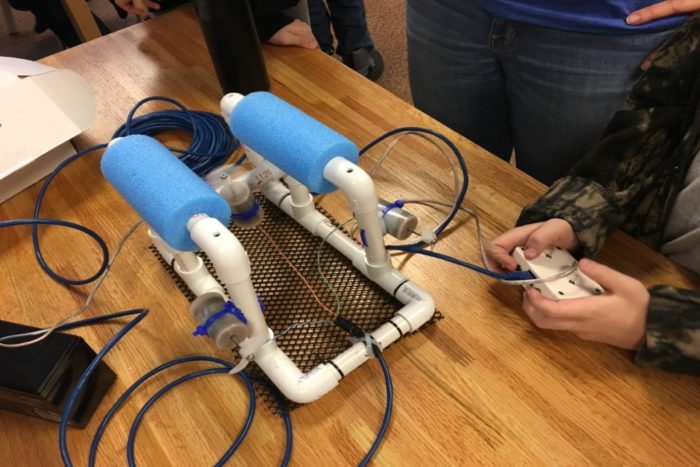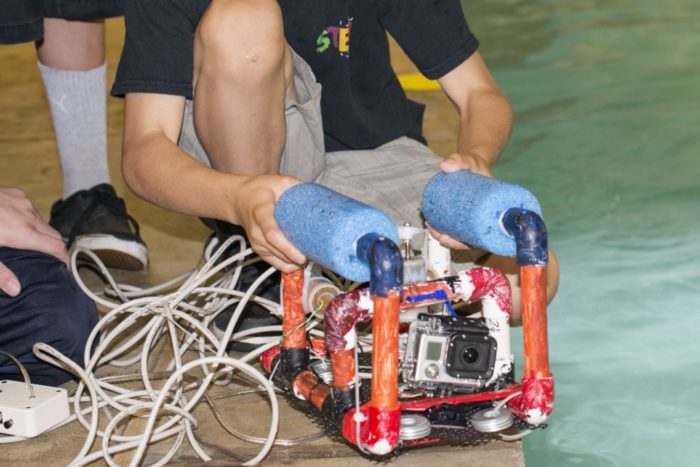
Oh, the places we ROVe!
By Andrea Schmuttermair, TASAA ROV Education Coordinator
Who doesn’t love a good story, especially one about adventure and the unknown? This is a story, a story of adventure, of the unknown. A story with unexpected twists and turns, one that has evolved over time. I am writing this from a coffee shop called “Wayfinder” — aptly named, for the story I am about to tell is one of navigation, exploration, pushing boundaries, taking chances on the unknown, and following the journey of what speaks to my heart.
 My name is Andrea Schmuttermair and I’m currently working with the National Marine Sanctuary Foundation as the Teacher at Sea Alumni Association ROV Education Coordinator. My journey with remotely operated vehicles (ROVs) began in 2015 when I was at dinner with a couple of friends (both marine scientists), brainstorming a final project to do with my fourth graders. It was the end of my second year at a new STEM school in Colorado, and I was eager to make the project STEM and marine science-focused. I had also recently stumbled upon five SeaPerch ROV kits in a closet at my school. One of my friends said, “Hey, why don’t we build those ROVs?” With only two months left in the school year, we took on a project that would challenge both my students and me as an educator.
My name is Andrea Schmuttermair and I’m currently working with the National Marine Sanctuary Foundation as the Teacher at Sea Alumni Association ROV Education Coordinator. My journey with remotely operated vehicles (ROVs) began in 2015 when I was at dinner with a couple of friends (both marine scientists), brainstorming a final project to do with my fourth graders. It was the end of my second year at a new STEM school in Colorado, and I was eager to make the project STEM and marine science-focused. I had also recently stumbled upon five SeaPerch ROV kits in a closet at my school. One of my friends said, “Hey, why don’t we build those ROVs?” With only two months left in the school year, we took on a project that would challenge both my students and me as an educator.
I had never built an ROV in my life, nor had I ever soldered anything, and my background in electricity and circuits was pretty basic. How was I going to lead students through this project?
This is when things finally clicked for me in what it meant to truly “guide” my students. I wasn’t an expert in what we were doing. I learned right along with my students. They saw me fail, try things different ways, and get frustrated. They also saw the light in my eyes when I solved a problem. They saw my excitement when I brought in the completed controller to school one day. I, too, was a student of ROVs, and I was able to model for my students how to take on the unknown and find answers along the way.
The students were jazzed to start this adventure with me, and I truly could not have asked for a better class to do this with. We had an overwhelming amount of support to build the ROVs. Our community saw the value in this project for the students, and they supported us every step of the way. The parent community volunteered their time and expertise as students learned how to use a saw and drill for the first time. One parent even brought in a horse trough that we filled with water to test our ROVs! A friend’s Women in Engineering Club came to teach students about the ROV controllers and how to solder. Marine scientists from Ocean First Institute came on a regular basis to help my “inland” students make a connection to the ocean and their organization hosted our first student-designed ROV competition.
The success and excitement of the ROV project that first year has fueled my work with ROVs in a myriad of ways ever since. In 2016, I ran an ROV 2.0 class, where students experimented with adding attachments like water quality sensor prototypes onto their ROVs. In 2017, I left for Finland on a Fulbright Distinguished Awards in Teaching Grant and little did I know that ROVs would follow me there, too. In Finland, I connected with Niko Nappu at Tvärminne Zoological Station and we talked about ROVs and their use at the research stations throughout country. I also worked with local educator, Kimmo Karell, who began to build ROVs with his students. The three of us presented our ROV project at a local technology conference in Finland.

Andrea, Niko, and Kimmo present their ROV project at a local conference in Finland.
The next year, I brought my passion for ROVs to Germany, where I taught math and science to elementary students. My students learned of the ROVs I had built in previous years, and they begged me to do an ROV project with them. With financial help from the Teacher at Sea Alumni Association (TASAA), we decided to try our hands at building the MATE Angelfish ROVs, and connected with scientists at GEOMAR: Helmholtz Centre for Ocean Research Kiel, a scientific research center in northern Germany. Students got to visit the research station, see real ROVs used around the world, and connect with ROV engineers, pilots, and biologists. They even got to try their hand at maneuvering the ROV (above water) and see the inside of the control container. I, too, was thrilled to take a reconnaissance trip to GEOMAR to see the ROVs that they use on research vessels in real life.
The common themes that emerged after all these years were that bringing ROVs into the classroom resulted in increased student engagement, fun, and enthusiasm for learning STEM subjects. I have never seen my students more engaged in their learning than through projects, and building ROVs has consistently ranked at the top of the list for student engagement.
As a result of all of these amazing and positive experiences, I’m excited to now be in a role that will enable me to share my knowledge of ROVs with an educator audience and to help build their capacity to bring ROVs to their students.
And so the ROV journey continues…where will we ROVe next?
To learn more about my ROV work with the Teacher at Sea Alumni Association through Project ROVe, check out this blog about our inaugural online course and hands-on workshop.
 Andrea Schmuttermair sailed on NOAA Ship Oregon II for a groundfish survey in 2012 and again in 2015 an alum on NOAA Ship Oscar Dyson for a pollock survey. In 2021, she joined the Teacher at Sea Alumni Association to pilot a new program—the Teacher at Sea Alumni Association NOAA Fellowship. After Andrea’s fellowship concluded, she stayed on with the Alumni Association to continue engaging alumni in remotely operated vehicle (ROV) professional development as part of the Project ROVe program she created.
Andrea Schmuttermair sailed on NOAA Ship Oregon II for a groundfish survey in 2012 and again in 2015 an alum on NOAA Ship Oscar Dyson for a pollock survey. In 2021, she joined the Teacher at Sea Alumni Association to pilot a new program—the Teacher at Sea Alumni Association NOAA Fellowship. After Andrea’s fellowship concluded, she stayed on with the Alumni Association to continue engaging alumni in remotely operated vehicle (ROV) professional development as part of the Project ROVe program she created.









